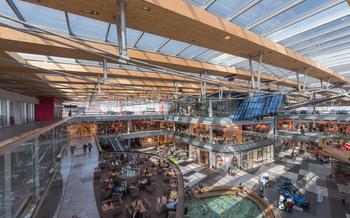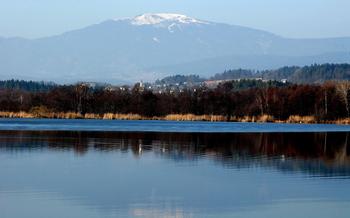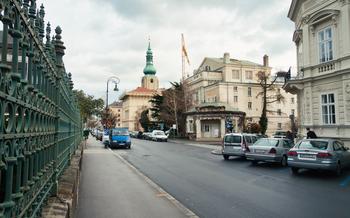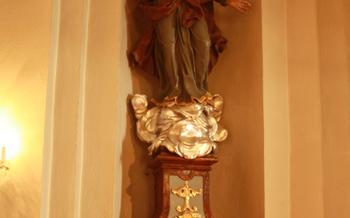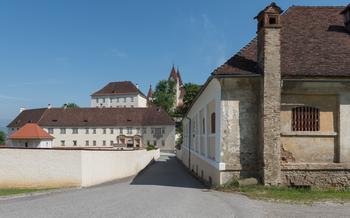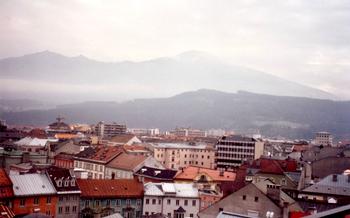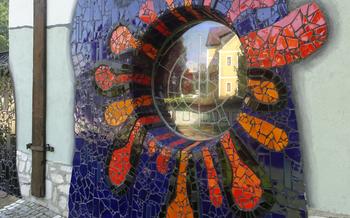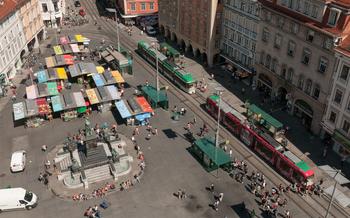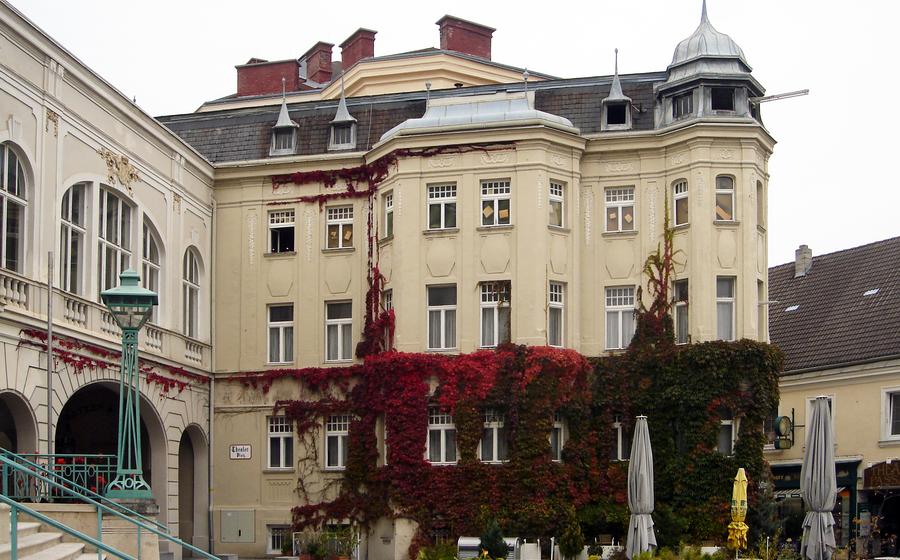
Klosterruine Baden
- The Baden Monastery in ruins
- A trip to the past
- Chapel of St. Helena
- Exploring the Monastery Grounds
- Photography enthusiasts' paradise
- Relaxing Oasis in the Heart of Baden
- Accessibility and facilities
- Planning your visit
- Accommodation options
- Restaurants and dining
The Baden Monastery in ruins
The Baden Monastery, also known as Klosterruine Baden, is a captivating historical landmark in Baden bei Wien, Austria. Its origins can be traced back to the 12th century, when it was established as a Benedictine monastery. Over the centuries, it underwent several expansions and renovations, reflecting the changing needs and tastes of its inhabitants. The monastery's heyday came in the 15th century, when it was a thriving center of religious and cultural activity. However, its fortunes declined during the Reformation, and it was eventually dissolved in 178The buildings were left to decay, and the ruins that remain today stand as a testament to the monastery's rich history.
The architectural features of the ruins reveal a blend of Romanesque and Gothic styles. The imposing walls, intricate arches, and delicate tracery windows hint at the grandeur of the original structure. Despite the ravages of time, the ruins still exude an aura of serenity and spirituality, inviting visitors to step back in time and imagine the lives of the monks who once called this place home.
Currently, the ruins are under the protection of the Austrian government and are open to the public as a historical site. Visitors can wander through the grounds, explore the remains of the church, cloisters, and other buildings, and soak in the unique atmosphere of this ancient place. The Klosterruine Baden stands as a symbol of the region's rich cultural heritage, serving as a reminder of the important role that monasteries played in shaping the history and development of Austria.
A trip to the past
The Klosterruine Baden has served as a backdrop for numerous films and historical reenactments, adding to its allure as a place where the past comes alive. The ruins have a palpable atmosphere that transports visitors back in time, allowing them to experience the grandeur and intrigue of a bygone era. From the crumbling walls and archways to the lush greenery that has enveloped the site, every element contributes to the feeling of stepping into a different century.
As you wander through the ruins, you can almost hear the echoes of monks chanting in the chapel, the hustle and bustle of pilgrims seeking solace, or the laughter and music of medieval feasts. The air is thick with history, inviting visitors to let their imaginations run wild and picture life within the monastery walls.
The Klosterruine Baden offers a unique opportunity to immerse oneself in the past and connect with the stories and legends that have shaped this iconic site. It is a place where history buffs, architecture enthusiasts, and anyone seeking a glimpse into a different era can find themselves captivated and transported to another time.
Chapel of St. Helena
The Chapel of St. Helena, nestled within the grounds of the Klosterruine Baden, is a testament to the rich religious heritage of the region. Built in the 13th century, this Gothic-style chapel exudes an air of serenity and devotion. Its simple yet elegant facade features pointed arches, intricate stone carvings, and delicate stained-glass windows that cast a warm glow on the interior.
The interior of the chapel is adorned with beautiful frescoes depicting scenes from the life of St. Helena, the mother of Emperor Constantine the Great. These vibrant and expressive paintings, created by skilled local artists, bring the stories of the saint to life, inviting visitors to contemplate her unwavering faith and devotion.
The chapel also houses a number of significant religious artifacts, including a 15th-century wooden statue of St. Helena and a collection of medieval manuscripts. These treasures offer a glimpse into the rich history of the chapel and the important role it played in the spiritual life of the community.
Over the centuries, the Chapel of St. Helena has served as a place of pilgrimage for those seeking solace, guidance, and divine intervention. Pilgrims from all over the region would flock to the chapel to pray to St. Helena, seeking her intercession in times of need. The chapel's reputation for miracles and answered prayers has made it a beloved and revered site among the local population.
Today, the Chapel of St. Helena continues to be a place of worship and reflection for visitors from all walks of life. Its tranquil atmosphere, awe-inspiring artwork, and historical significance make it a must-visit destination for anyone interested in the cultural and religious heritage of Austria.
Exploring the Monastery Grounds
The sprawling grounds of the Klosterruine Baden are a treasure trove for history buffs and nature lovers alike. As you wander through the ruins, you'll encounter remnants of the cloisters, the church, and various outbuildings, each with its own story to tell. The church, once the heart of the monastery, still boasts impressive Gothic arches and intricate stone carvings. The cloisters, with their delicate tracery windows and serene atmosphere, invite you to imagine the monks' daily lives.
Archaeological excavations have uncovered a wealth of artifacts, shedding light on the monastery's past. These include pottery shards, coins, and even fragments of frescoes, providing glimpses into the daily lives of the monks who once called this place home.
Beyond the historical significance, the monastery grounds offer a sanctuary of natural beauty. Set amidst lush greenery, the ruins are surrounded by towering trees, vibrant flowerbeds, and manicured lawns. Take a leisurely stroll, find a secluded spot to sit and soak in the tranquility, or simply let your imagination run wild as you explore this enchanting place.
Photography enthusiasts' paradise
The Klosterruine Baden is a photographer's paradise, offering a multitude of opportunities to capture unique and striking images. The weathered stones, intricate carvings, and dramatic lighting conditions combine to create a visually captivating scene. For the best lighting, aim to visit during the golden hours of sunrise and sunset, when the warm hues of the sky cast a magical glow on the ruins.
Photographing ruins presents both challenges and rewards. The unpredictable nature of the lighting and the often complex compositions can test even experienced photographers. However, the rewards are immense, as the resulting images can convey a sense of history, mystery, and awe that is unmatched by other subjects.
To capture the essence of the Klosterruine Baden, experiment with different angles and perspectives. Climb the spiral staircase to the top of the bell tower for a bird's-eye view of the ruins, or venture into the crypt to capture the eerie beauty of the underground chambers. Don't be afraid to play with shadows and silhouettes to create dramatic effects, and use long exposure times to blur the movement of the clouds or water for a sense of ethereal stillness.
Whether you are an amateur photographer or a seasoned professional, the Klosterruine Baden is sure to provide you with an unforgettable photographic experience. So bring your camera, embrace the challenges, and let your creativity soar amidst the ruins of this ancient monastery.
Relaxing Oasis in the Heart of Baden
Amidst the ancient walls of the Klosterruine Baden, a serene oasis unfolds, inviting visitors to find tranquility and rejuvenation. The ruins, enveloped in a mystical aura, exude a sense of peace that permeates the surrounding area. As you step through the gates, the hustle and bustle of the city melt away, replaced by a tranquil ambiance that envelops your senses.
Take a leisurely stroll through the ruins, marveling at their architectural grandeur and the intricate details that have withstood the test of time. Discover secluded nooks and crannies where you can sit and soak in the serenity of the surroundings. Let the gentle breeze caress your skin as you listen to the birdsong that fills the air.
The lush parks and gardens that embrace the ruins offer a verdant haven for relaxation. Stroll along the winding paths, admire the colorful blooms, and breathe in the sweet fragrance of the flowers. Find a cozy spot beneath a shady tree, spread out a blanket, and indulge in a delightful picnic with friends or family.
Whether you seek solace from the demands of daily life or simply crave a moment of tranquility, the Klosterruine Baden offers a sanctuary of peace and tranquility. Let the ancient ruins transport you to a realm of serenity, where time slows down, and your worries dissipate, leaving you refreshed and revitalized.
Accessibility and facilities
Visiting the Klosterruine Baden is a breeze, thanks to its convenient location and accessible facilities. Whether you're arriving by public transport or car, you'll find the ruins within easy reach.
Multiple bus lines stop nearby, making it a convenient option for those without a vehicle. For drivers, ample parking spaces are available in the vicinity, ensuring a hassle-free visit.
For those with limited mobility, the ruins are wheelchair accessible, allowing everyone to explore the site comfortably. Restrooms are also available on-site, providing convenience and peace of mind.
While refreshments are not directly available within the ruins, visitors can find a variety of cafes, restaurants, and snack bars just a short walk away. This allows you to grab a bite to eat or a refreshing drink before or after your visit, making it a complete and enjoyable experience.
Planning your visit
Visiting the Klosterruine Baden is a rewarding experience that can be enjoyed throughout the year. However, choosing the right time to visit can enhance your experience even more. During the summer months, the surrounding parks and gardens are in full bloom, creating a vibrant and colorful backdrop to the ruins. The warm weather also invites visitors to linger longer and explore the grounds at their leisure.
To avoid the crowds and enjoy a more intimate atmosphere, consider visiting during the shoulder seasons (spring and autumn). The weather is typically mild and pleasant during these periods, making it ideal for exploring the ruins without the summer heat or the winter chill.
No matter when you choose to visit, be sure to plan for at least two hours to fully appreciate the site. Allow ample time to wander through the ruins, explore the chapel, and soak in the tranquil atmosphere. You may also want to consider booking a guided tour to gain insights into the history and significance of the monastery.
To make the most of your visit, arrive early in the morning or late in the afternoon to avoid the midday sun. Wear comfortable shoes as you will be doing a lot of walking on uneven surfaces. Also, bring a camera to capture the stunning beauty of the ruins and the surrounding landscapes.
Accommodation options
When planning your visit to the Klosterruine Baden, you'll find a range of accommodation options to suit your needs and budget. The town of Baden bei Wien offers a variety of hotels, guesthouses, and vacation rentals.
For a luxurious stay, consider the Grand Hotel Sauerhof, a historic hotel with elegant rooms and a rooftop terrace with stunning views of the town and the surrounding hills. If you prefer a more budget-friendly option, the Gästehaus Frau Maria offers comfortable rooms and a friendly atmosphere.
For a unique experience, you can opt for a vacation rental. These properties offer the privacy and flexibility of your own home, combined with the convenience of being located near the ruins. Websites like Airbnb and Vrbo offer a wide selection of vacation rentals in Baden bei Wien.
No matter what your budget or preferences, you'll find a suitable accommodation option in Baden bei Wien. Remember to book your stay in advance, especially during peak tourist season, to secure the best rates and availability.
Restaurants and dining
After exploring the captivating ruins of Klosterruine Baden, you'll undoubtedly have worked up an appetite. Luckily, Baden bei Wien offers a diverse culinary scene to satisfy every palate. For a taste of traditional Austrian cuisine, head to Gasthaus zum Goldenen Hirschen, a cozy tavern serving hearty Viennese dishes like schnitzel and Tafelspitz. For international flavors, try La Taperia, a Spanish tapas bar with a lively atmosphere.
If you're seeking a dining experience with a view, reserve a table at Restaurant Dommayer, located within the Doblhoffpark. This elegant restaurant offers panoramic views of the surrounding greenery and the ruins, creating a magical ambiance for your meal.
For a unique culinary adventure, book a table at the Klosterkeller, a restaurant housed within the former monastery's wine cellar. This atmospheric venue offers a delightful menu inspired by medieval recipes, transporting you back in time as you savor your meal in the historic surroundings.
No matter your preference, Baden bei Wien has a culinary delight waiting for you. Indulge in traditional Austrian fare, explore international cuisines, or savor a meal with a view – the choice is yours.
